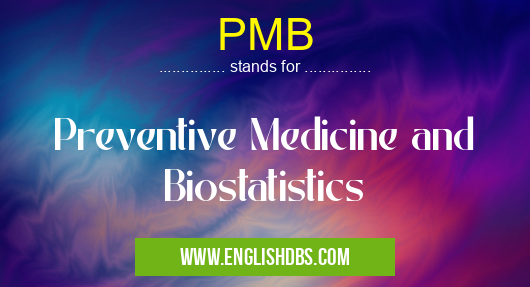What does PMB mean in STATISTICS
Preventive Medicine and Biostatistics (PMB) is a multidisciplinary field that utilizes scientific, medical, and statistical methods to prevent disease and promote health. PMB professionals work in various settings, including healthcare, academia, and public health agencies.

PMB meaning in Statistics in Academic & Science
PMB mostly used in an acronym Statistics in Category Academic & Science that means Preventive Medicine and Biostatistics
Shorthand: PMB,
Full Form: Preventive Medicine and Biostatistics
For more information of "Preventive Medicine and Biostatistics", see the section below.
How PMB works
PMB professionals gather and analyze data on population health, disease patterns, and risk factors. They use this information to identify and evaluate preventive measures, such as:
- Vaccination programs
- Screening and early detection initiatives
- Health promotion campaigns
- Environmental health regulations
PMB in healthcare
PMB plays a crucial role in healthcare by:
- Guiding clinical decision-making
- Developing and evaluating preventive interventions
- Monitoring and evaluating the effectiveness of healthcare systems
PMB in research
PMB professionals conduct research studies to:
- Identify risk factors for disease
- Evaluate the effectiveness of preventive measures
- Develop new preventive strategies
PMB in public health
PMB is essential for public health initiatives, such as:
- Surveillance and monitoring of disease outbreaks
- Health policy development
- Community health assessment
Essential Questions and Answers on Preventive Medicine and Biostatistics in "SCIENCE»STATISTICS"
What is Preventive Medicine and Biostatistics (PMB)?
PMB is a field of study that integrates preventive medicine and biostatistics. Preventive medicine focuses on preventing disease and promoting health, while biostatistics involves the collection, analysis, and interpretation of data related to health and disease. PMB professionals use this data to develop and evaluate strategies for preventing and controlling diseases.
What types of careers are available in PMB?
PMB graduates can pursue careers in various fields, including:
- Epidemiology: Studying the distribution and causes of disease in populations
- Public health policy: Developing and implementing policies to improve public health
- Health education: Educating individuals and communities about health and disease prevention
- Clinical research: Conducting clinical trials to evaluate new treatments and interventions
- Data science: Using statistical techniques to analyze health and medical data
What are the educational requirements for a career in PMB?
Most PMB professionals hold a Master's degree in Public Health (MPH) or a Doctorate in Public Health (DrPH). These programs typically require coursework in epidemiology, biostatistics, and other public health disciplines. Some programs may also offer specialized tracks in areas such as environmental health or health policy.
What are the job prospects for PMB professionals?
The job outlook for PMB professionals is expected to grow faster than average in the coming years, according to the U.S. Bureau of Labor Statistics. This growth is driven by increasing awareness of the importance of disease prevention and the need for professionals to analyze and interpret health data.
What are the potential salary ranges for PMB professionals?
Salaries for PMB professionals vary depending on experience, education, and job title. According to Salary.com, the median salary for an Epidemiologist is $93,204, while the median salary for a Biostatistician is $103,815.
Final Words: PMB is a rapidly growing field that is essential for improving public health and preventing disease. PMB professionals play a vital role in developing and evaluating preventive measures, conducting research, and informing health policy.
PMB also stands for: |
|
| All stands for PMB |
